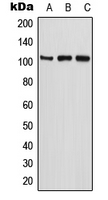Anti-ETAA1 Antibody
- SPECIFICATION
- CITATIONS
- PROTOCOLS
- BACKGROUND

Application
| WB |
|---|---|
| Primary Accession | Q9NY74 |
| Reactivity | Human, Rat |
| Host | Rabbit |
| Clonality | Polyclonal |
| Calculated MW | 103440 Da |
| Gene ID | 54465 |
|---|---|
| Other Names | ETAA16; Ewing's tumor-associated antigen 1; Ewing's tumor-associated antigen 16 |
| Target/Specificity | Recognizes endogenous levels of ETAA1 protein. |
| Dilution | WB~~1/500 - 1/1000 |
| Format | Liquid in 0.42% Potassium phosphate, 0.87% Sodium chloride, pH 7.3, 30% glycerol, and 0.09% (W/V) sodium azide. |
| Storage | Store at -20 °C.Stable for 12 months from date of receipt |
| Name | ETAA1 (HGNC:24648) |
|---|---|
| Function | Replication stress response protein that accumulates at DNA damage sites and promotes replication fork progression and integrity (PubMed:27601467, PubMed:27723717, PubMed:27723720). Recruited to stalled replication forks via interaction with the RPA complex and directly stimulates ATR kinase activity independently of TOPBP1 (PubMed:27723717, PubMed:27723720, PubMed:30139873). Probably only regulates a subset of ATR targets (PubMed:27723717, PubMed:27723720). |
| Cellular Location | Nucleus Note=Localizes at sites of DNA damage following replication stress (PubMed:27601467, PubMed:27723717, PubMed:27723720). Recruited to stalled replication forks via interaction with RPA1 and RPA2 subunits of the RPA complex (PubMed:27601467, PubMed:27723720) |
| Tissue Location | Expressed at high levels in the brain, liver kidney and Ewing tumor cell lines. |

Thousands of laboratories across the world have published research that depended on the performance of antibodies from Abcepta to advance their research. Check out links to articles that cite our products in major peer-reviewed journals, organized by research category.
info@abcepta.com, and receive a free "I Love Antibodies" mug.
Provided below are standard protocols that you may find useful for product applications.
Background
Rabbit polyclonal antibody to ETAA1
If you have used an Abcepta product and would like to share how it has performed, please click on the "Submit Review" button and provide the requested information. Our staff will examine and post your review and contact you if needed.
If you have any additional inquiries please email technical services at tech@abcepta.com.













 Foundational characteristics of cancer include proliferation, angiogenesis, migration, evasion of apoptosis, and cellular immortality. Find key markers for these cellular processes and antibodies to detect them.
Foundational characteristics of cancer include proliferation, angiogenesis, migration, evasion of apoptosis, and cellular immortality. Find key markers for these cellular processes and antibodies to detect them. The SUMOplot™ Analysis Program predicts and scores sumoylation sites in your protein. SUMOylation is a post-translational modification involved in various cellular processes, such as nuclear-cytosolic transport, transcriptional regulation, apoptosis, protein stability, response to stress, and progression through the cell cycle.
The SUMOplot™ Analysis Program predicts and scores sumoylation sites in your protein. SUMOylation is a post-translational modification involved in various cellular processes, such as nuclear-cytosolic transport, transcriptional regulation, apoptosis, protein stability, response to stress, and progression through the cell cycle. The Autophagy Receptor Motif Plotter predicts and scores autophagy receptor binding sites in your protein. Identifying proteins connected to this pathway is critical to understanding the role of autophagy in physiological as well as pathological processes such as development, differentiation, neurodegenerative diseases, stress, infection, and cancer.
The Autophagy Receptor Motif Plotter predicts and scores autophagy receptor binding sites in your protein. Identifying proteins connected to this pathway is critical to understanding the role of autophagy in physiological as well as pathological processes such as development, differentiation, neurodegenerative diseases, stress, infection, and cancer.


